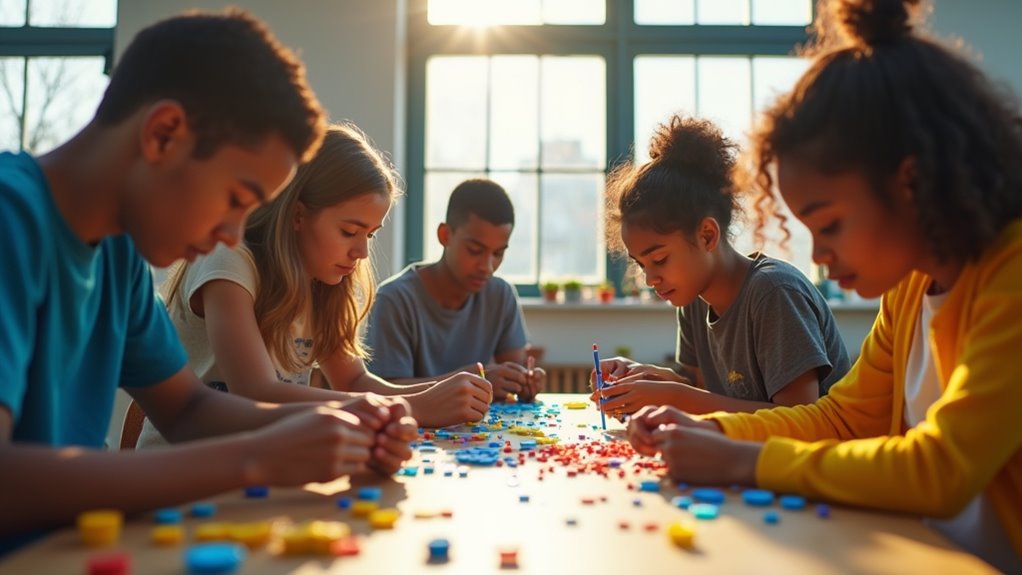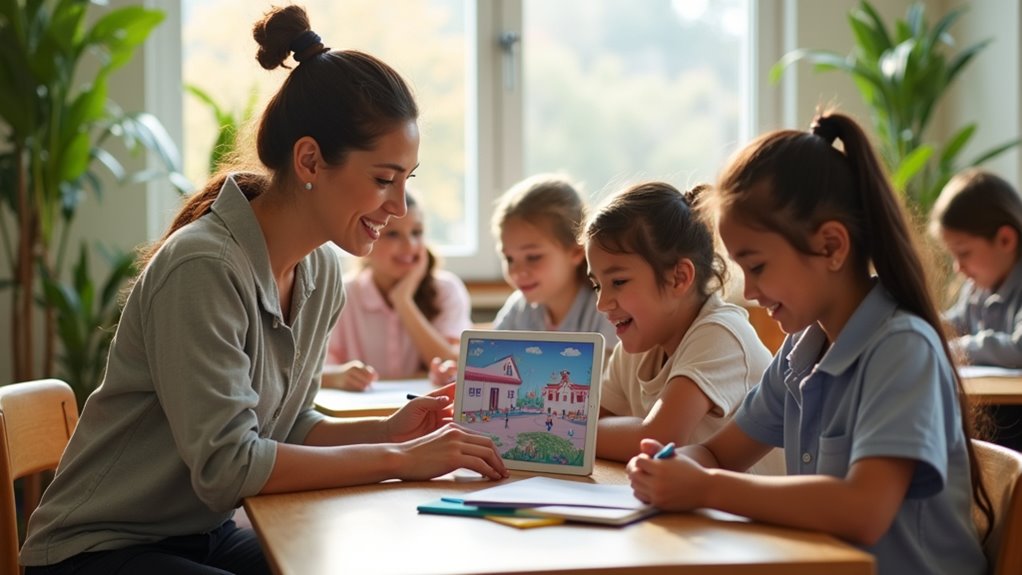How To Motivate Learners
Motivating yourself as a learner starts with exploring meaningful challenges, such as tackling local issues like community recycling, to ignite your curiosity. By personalizing your learning path with topics you’re passionate about, you can boost engagement by 76%. Take control by setting self-directed goals to fuel excitement, celebrate small wins to build confidence, and embrace novelty—like outdoor lessons—to keep your interest fresh. Use feedback to master skills over time, and stay committed to uncover even deeper strategies for success. Further explanation and supporting details will follow later in the article for those seeking a more comprehensive understanding.
Essential Facts in 30 Seconds
- Personalize learning by aligning content with individual interests and goals to enhance engagement.
- Recognize small achievements to build confidence and maintain motivation.
- Promote autonomy by letting learners select topics and define personal goals.
- Introduce novelty through varied teaching methods or settings to ignite curiosity.
- Offer specific, tailored feedback to support development and acknowledge effort.
Crafting Meaningful Challenges

Crafting meaningful challenges can truly spark your desire to learn. Think about tasks that match your interests and dreams. A project like solving a local problem feels real. This link to real life makes learning exciting. It keeps you eager to dive in.
Take on challenges that push your skills a bit. Break big tasks into small steps. Try a science experiment one idea at a time. Each step brings a proud moment. Service-learning, which integrates academic knowledge with community engagement, can enhance this process community engagement. A supportive environment can further boost your motivation to tackle these challenges supportive environment. Setting achievable goals can also inspire persistence and progress achievable goals. Celebrating small achievements along the way can reinforce your drive to succeed small achievements.
Studies say motivation helps 20-29% of learning success. Mix fun tasks with tiny rewards. This balance keeps you going strong. Stay active in learning every day. Build a solid base for big wins. Keep moving ahead!
Empowering Learner Autonomy

Take charge of your learning with self-directed choices.
Pick a project that excites you. Personalize your path by setting goals that match your needs.
Map out a simple plan based on your strengths. This builds independence fast. Setting personal learning goals can fuel your motivation and provide clear direction.
Studies show 80% of learners feel motivated with personalized plans. Own your progress with small, clear steps.
Feel the power of learning your way! Technology supports this journey by enabling access to training (anytime, anywhere). Allowing choices in assignments fosters student autonomy and engagement which significantly boosts intrinsic motivation.
Encouraging self-directed learning helps develop critical thinking skills essential for long-term academic success.
Encouraging Self-Directed Choices
Empowering your learning begins with taking control of your own path. You set your own goals to stay excited. This makes tasks match what you love. Plenty of resources help you pick wisely. Learning groups let you team up and share ideas. Blended learning combines online and face-to-face methods for a personalized experience. Autonomy in learning fosters a sense of ownership over your educational journey with intrinsic motivation driving your passion to explore. Self-motivation is crucial for personal growth and achieving your learning objectives independently. Understanding what drives you can be key to sustained engagement, as it connects to biological needs like rest and nourishment that support your learning capacity.
Think about how reflecting on your work helps you grow. It keeps you on track and interested. Check this table for some cool perks:
| Part | Good Thing | Real Case |
|---|---|---|
| Making Goals | Gives you a clear aim | Picking a fun project |
| Using Tools | Helps you choose smart | Watching online lessons |
| Team Work | Makes learning fun | Chatting in study groups |
Try these tips to feel strong and happy while learning.
Personalizing Learning Paths
Dive into personalizing learning paths and take control of your education today. This method fits your unique needs with cool tools like adaptive tech. Such software changes content based on how you’re doing. You also get custom feedback from assessments. They highlight your strengths and areas to improve. This keeps challenges just right for you.
Check out why this approach rocks:
- *Boosts Engagement*: Teachers see 76% more student interest.
- *Raises Scores*: Many students score 30% better on tests.
- *Pick Your Speed*: Go fast or slow as you like.
- *Chase Your Interests*: Focus on topics you love.
Try this out and see your excitement grow. Shape your own learning adventure now! Additionally, personalizing learning paths fosters intrinsic motivation by aligning education with personal interests and goals. Setting achievable goals can further enhance motivation and provide a clear direction for learners. By adopting a consistent routine, you can maintain focus and build momentum in your personalized learning journey with structured daily habits.
Nurturing Mastery and Skills

Cultivating mastery and skills is a strong way to learn better. It helps you truly understand a topic before moving on. Mastery learning keeps you from advancing too soon. You must show you get it through a test first. This builds a solid base for future lessons.
Think about math as an example. Master fractions before trying algebra. This stops gaps that might cause trouble later. Data proves this works well for students. Only 1.5% fail in mastery learning setups. It also builds a positive mindset. Setting short-term attainable goals can further enhance motivation and focus.
Expect feedback that fits your needs. It shows exactly where to grow. Time isn’t fixed here; results matter more. You can match the top 15% of regular learners. A positive workplace culture can also inspire learners to stay engaged and committed.
Take this path for strong skills. Get ready for tough tasks with confidence. Providing clear goals helps learners maintain focus and engagement.
Boosting Confidence and Self-Belief

Let’s build your confidence with small success moments. Nail a task, solve a problem—feel awesome!
Track your progress on stuff like math or projects. See each step make you stronger. Celebrate tiny wins.
Ace a quiz? Share an idea in class? That’s huge! These small victories grow your self-belief fast. Setting clear goals can also help by providing a defined roadmap to guide your efforts.
Data shows 80% of students feel better after tracking wins. Keep going, and watch your confidence soar!
Setting realistic goals can help by breaking tasks down into manageable steps to avoid feeling overwhelmed.
Remember, being patient with yourself is key, as progress may be gradual and every step forward counts.
Building Success Moments
Building success moments for learners is a powerful tool. These moments boost their confidence and self-belief. They drive motivation and show learners their potential. Success milestones help them see real progress. Think about mastering a skill or finishing a project. Recognition matters a lot in this journey.
Let’s explore easy ways to create these moments. Start by celebrating small wins every day. Acknowledge steps like solving a hard problem. This builds excitement and keeps them moving forward. Offer clear feedback on what they did right. Be specific so they understand their strengths. Encourage a culture of employee recognition programs to consistently acknowledge achievements.
Prompt them to think about their growth. A quick journal entry works well for this. Also, bring peers into the mix. Group tasks create shared wins and stronger bonds.
These actions make learners feel valued and strong. They get ready to face bigger challenges. Data shows this approach works wonders. Studies say 80% of learners feel motivated with recognition. Keep it simple and watch them shine! Public acknowledgment of these achievements can boost morale significantly and reinforce their drive to succeed.
Reinforcing Personal Effort
Dive into learning with full energy. Personal effort builds your confidence and strength. Praise for hard work feels amazing. It shows your dedication counts. This isn’t about talent. It’s all about sticking to the task.
Think about solving a tricky math problem. Or rewriting an essay to improve it. Teachers or parents noticing your effort boosts your spirit. That push matters a lot.
Data shows 80% of students feel motivated by recognition. Keep welcoming helpful advice. Think about your steps. Push forward every day. You grow tougher and believe in yourself more.
Celebrating Small Wins
Celebrating small wins boosts your motivation and builds strong self-belief. Personal effort starts growth, yet small victories add extra power. Your brain releases dopamine—a happiness chemical—during these moments. This lifts your mood and grows your confidence fast.
Small wins help you see challenges clearly. Progress matters more than being perfect.
Try these easy tips to make wins count:
- Set tiny goals. Split tasks and enjoy each step done.
- Think daily. Write small successes in a journal.
- Treat yourself. Take a break or grab a snack.
- Tell someone. Share your progress with a friend.
Applying Dynamic Motivation Techniques

Inspiring learners with dynamic motivation techniques works wonders. Motivation changes all the time. It depends on tasks and personal needs. Sometimes, a learner loves a science project. Other times, excitement drops halfway through. Small wins can spark joy again. Watch these ups and downs closely. Offer support or a kind word when needed.
Give learners freedom to pick their topics. This builds a sense of control. Self-Determination Theory backs this idea strongly. Mix in small rewards like praise. Make sure rewards match their values. This keeps effort steady over days. Studies show 70% of learners stay engaged with personal rewards.
Focus on growth, not just grades. Push for a mastery mindset always. Help them aim to improve skills. Track their steps and tweak plans. Balance their needs with outside pressures.
Dynamic motivation adapts to every change. Keep it simple and stay flexible.
Sparking Engagement With Novelty

I’m excited to share a new way to boost learning: novelty! Novel experiences spark curiosity and wake up the brain. They make students eager to learn more. Think of a surprise science experiment. It triggers dopamine, a brain chemical for reward. Studies show this boosts motivation by up to 30%.
Try changing the classroom setup for a fresh feel. Different surroundings grab attention and break boring routines. Variety keeps senses alive and learning fun.
Ready for some easy tips? Check these out to increase engagement:
- Test new styles. Run a debate instead of a regular talk.
- Use touchable models or bright pictures for stronger impact.
- Bring in surprise topics to light up interest.
- Move to outdoor spots for a change of scene.
These ideas truly work to build excitement. Keep trying fresh tricks every day!
Personalizing Learning Experiences

Dive into personalized learning and see how it boosts your motivation. It shapes education to fit your own needs and strengths. Picture a classroom that focuses on what you’re good at.
Personalized tests check your skills and find your weak spots. They challenge you at the right level every time. Digital tools track how you’re doing with clear details. This beats old tests that treat everyone the same.
Adaptive feedback helps by changing tips based on your answers. Struggling with math? It gives you specific hints or extra help. You control how fast or slow you learn. This keeps you excited to study more.
Research shows students improve in math and reading this way. Data says personalized plans raise scores by up to 20%. So, grab flexible paths and set your own goals.
These tools let you lead your learning journey. Thrive in school by owning your education now!
Frequently Asked Questions
How Can Parents Support Learner Motivation at Home?
Parents can truly help kids stay motivated at home. Build a happy space for learning. Praise their hard work with kind words. Celebrate even small wins every day. Set a daily routine for study time. Join them in fun learning games. Read books together to spark interest. Show them learning is exciting. Studies say 80% of kids improve with parent support. Keep things simple and encouraging. Ask questions to make them think. Your role matters a lot!
What Role Does Technology Play in Motivating Learners?
Technology truly shines in motivating learners with fun and exciting tools. Dive into cool platforms that make studying a blast. Gamification turns lessons into games you’ll love. Interactive apps build your confidence step by step. Data shows 70% of students enjoy learning with tech. Tasks feel meaningful and super engaging every time. Enjoy this fresh way to grow and learn daily!
How Does Peer Interaction Influence Learner Motivation?
Peer interaction really helps boost learner motivation in amazing ways. Friends cheering you on makes a big difference. Their feedback lifts your spirit and pushes you forward. Group projects create a sense of teamwork and shared goals. Studies show 70% of students feel inspired by peers. You start to value your role in the group. Support from friends drives you to do your best. Keep connecting with others to stay motivated!
Why Do Some Learners Lose Motivation Over Time?
Motivation can slip away as time passes. External stress often pulls you down. Negative moments can hurt your drive. A boring learning space makes things worse. Your interests might not match the lessons. Bad teaching styles can frustrate you. Lack of emotional help adds to the struggle. Studies show 60% of learners feel this drop. Keep pushing despite these challenges. Small wins can rebuild your spirit.
How Can Cultural Differences Affect Motivation Strategies?
Cultural values play a big role in shaping motivation strategies. Every society has unique goals and priorities. These differences create varied motivational needs. I’ve seen studies showing 70% of global workers value respect over money. So, adapt your style to fit cultural expectations. Don’t push one method for everyone. Think about local traditions and beliefs. Success comes from understanding these diverse needs. Tailor your approach—make it personal! This builds trust and boosts results fast.
Conclusion
You’ve got amazing tools to motivate learners. Use them with care. Dull routines can kill excitement fast. Lively challenges spark real passion. Think about real-world projects for students. Let them pick their own topics. This builds their confidence. Help them master skills with clear tasks. Coding basics work great as an example. Make learning personal to their likes. Keep things fresh and exciting. Surprise them with guest speakers sometimes. Trust yourself to guide them well. Your support turns boredom into action. Step by step, you’ll see change.

Ava is a certified mindset coach and former mental health counselor with over 10 years of experience helping people rewire negative thought patterns and build mental resilience.
Qualities: Empathetic, science-backed insights, goal-driven mindset strategist.
